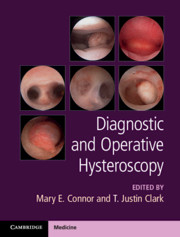Book contents
- Diagnostic and Operative Hysteroscopy
- Diagnostic and Operative Hysteroscopy
- Copyright page
- Dedication
- Contents
- Videos
- Contributors
- Chapter 1 An Introduction to Hysteroscopy
- Chapter 2 Anatomy and Physiology of the Uterus
- Chapter 3 Infrastructure and Instrumentation for Hysteroscopy
- Chapter 4 Diagnostic Hysteroscopy: Accuracy and Interpretation of Findings
- Chapter 5 Hysteroscopy Techniques and Treatment Settings
- Chapter 6 Analgesia and Anaesthesia for Hysteroscopy
- Chapter 7 Indications for Hysteroscopy
- Chapter 8 Hysteroscopic Electrosurgery
- Chapter 9 Complications of Hysteroscopic Surgery
- Chapter 10 Hysteroscopic Endometrial Polypectomy
- Chapter 11 Endometrial Ablation
- Chapter 12 Hysteroscopic Management of Fibroids
- Chapter 13 Hysteroscopic Sterilisation
- Chapter 14 Management of Congenital Uterine and Vaginal Anomalies
- Chapter 15 Hysteroscopic Management of Uterine Adhesions
- Chapter 16 Unusual Hysteroscopic Situations: Caesarean Niche and Retained Placental Tissue
- Chapter 17 Audit, Data Collection and Clinical Governance in Hysteroscopy
- Chapter 18 Training in Hysteroscopic Skills
- Chapter 19 Research and New Developments in Hysteroscopy
- Index
- References
Chapter 7 - Indications for Hysteroscopy
Published online by Cambridge University Press: 10 September 2020
- Diagnostic and Operative Hysteroscopy
- Diagnostic and Operative Hysteroscopy
- Copyright page
- Dedication
- Contents
- Videos
- Contributors
- Chapter 1 An Introduction to Hysteroscopy
- Chapter 2 Anatomy and Physiology of the Uterus
- Chapter 3 Infrastructure and Instrumentation for Hysteroscopy
- Chapter 4 Diagnostic Hysteroscopy: Accuracy and Interpretation of Findings
- Chapter 5 Hysteroscopy Techniques and Treatment Settings
- Chapter 6 Analgesia and Anaesthesia for Hysteroscopy
- Chapter 7 Indications for Hysteroscopy
- Chapter 8 Hysteroscopic Electrosurgery
- Chapter 9 Complications of Hysteroscopic Surgery
- Chapter 10 Hysteroscopic Endometrial Polypectomy
- Chapter 11 Endometrial Ablation
- Chapter 12 Hysteroscopic Management of Fibroids
- Chapter 13 Hysteroscopic Sterilisation
- Chapter 14 Management of Congenital Uterine and Vaginal Anomalies
- Chapter 15 Hysteroscopic Management of Uterine Adhesions
- Chapter 16 Unusual Hysteroscopic Situations: Caesarean Niche and Retained Placental Tissue
- Chapter 17 Audit, Data Collection and Clinical Governance in Hysteroscopy
- Chapter 18 Training in Hysteroscopic Skills
- Chapter 19 Research and New Developments in Hysteroscopy
- Index
- References
Summary
Improved hysteroscopic technology has enabled clinicians not only to perform diagnostic outpatient hysteroscopy but also to treat uterine lesions. Bipolar diathermy electrodes have reduced the risk of fluid overload, allowing the excision of larger fibroids at a single setting and thus reducing the need for abdominal operations. Novel indications for hysteroscopy have become available, such as hysteroscopic tubal occlusion. Concomitant developments in hysteroscopic equipment and ultrasound technology have influenced how these tools are used in the diagnosis and treatment of intrauterine conditions.
- Type
- Chapter
- Information
- Diagnostic and Operative Hysteroscopy , pp. 83 - 95Publisher: Cambridge University PressPrint publication year: 2020



